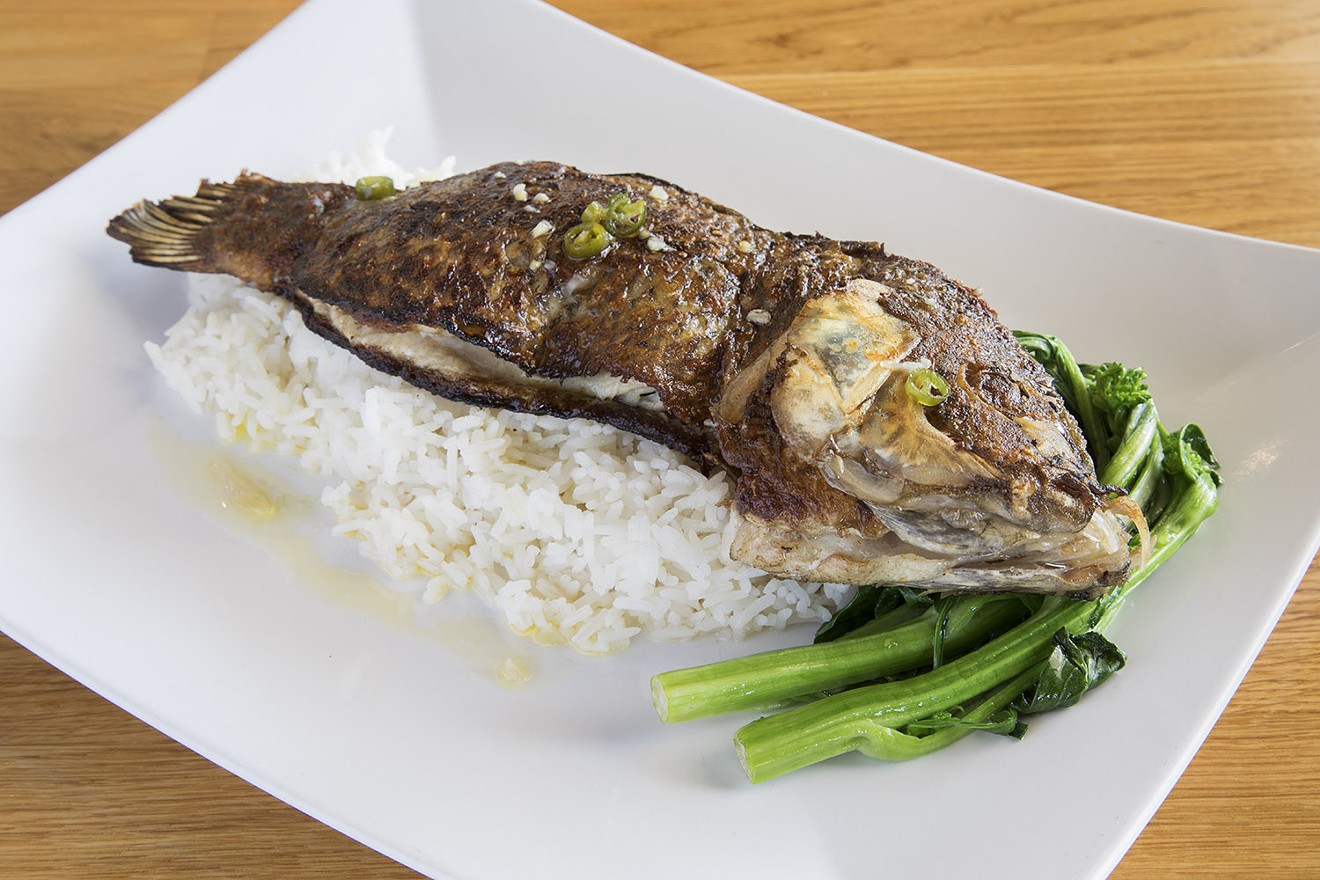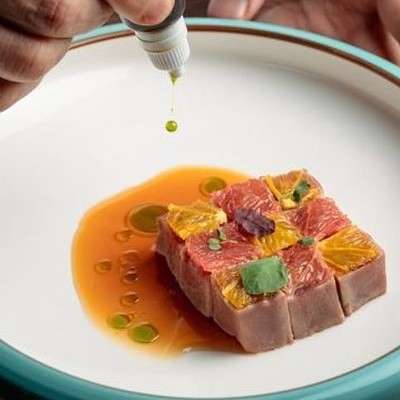Borrowing from neighboring Laos and Thailand, the papaya salad on the menu at Maba Pan-Asian Diner is a harmonious mingling of Vietnamese and Southeast Asian flavors and should very well be the flagship of this new Pan-Asian diner tucked snugly in the corner of Gray and Brazos in Midtown. The crisp, unripened shreds of light green papaya, carrots and red onions, mixed with julienned cucumber, slices of red and green jalapeños, a couple of halved cherry tomatoes, shrimp and a few thin slivers of broiled pork belly are tossed in a tangy nuoc mam cham (Vietnamese dipping fish sauce) and crowned with crushed peanuts, chopped cilantro stems and leaves.
The cold salad crunched and squished with each bite, the jalapeño delivered on the spice and the nuoc mam cham was familiar but somehow foreign and distinct, and left us wanting to order a second helping.
The name Maba is a combination of the Vietnamese words Ma (mom) and Ba (dad), and according to the restaurant’s profile, chef/owner Wayne Nguyen aimed to honor his parents and his Vietnamese heritage by offering a simple menu with items that reflected his birthplace, while incorporating the influences of an American upbringing in a culturally diverse environment. The counter-service, casual diner with a great outdoor covered patio is a welcome addition to Midtown.
The list of appetizers alone demonstrates Nguyen’s adherence to popular demand. From edamame and vegetarian spring rolls to chicken satay and a pork belly taco, Maba stays true to the “pan-Asian“ part of its name to offer a little something in a variety of Southeast Asian cuisines.
The pork belly taco was very promising. A few slices of slow-roasted, marinated pork belly were presented with cucumber, jalapeño, red onion and cilantro drizzled with sriracha and hoisin, all tucked inside and outside of the Taiwanese scallion pancake.
Scallion pancakes are more similar to pizzas than to pancakes, in that they are made of dough instead of a batter. A Taiwanese pancake is folded with oil and minced green onions (scallions) and resembles unleavened flatbread once it’s pan-fried to a crisp. Maba’s version was a bit on the thick side and would’ve benefited from more time in the pan. It tasted too doughy and lacked the crispiness expected in typical Taiwanese scallion pancakes.
The pork belly was exceptionally tasty,but was very greasy, apparently as a result of being prepared with a twice-cooking technique that many Chinese restaurants use. The taco was overloaded with finger-size pieces of cucumber, and a pool of grease from the pork settled into the pancake, rendering it less than appetizing.
There are three fish options on the menu: ginger miso salmon, steamed tilapia or pan-fried lemongrass tilapia. We opted for the latter because it sounded close to a dish that I’ve grown up eating in my own Vietnamese home.
While at the counter, I asked if tilapia was the only choice for the pan-fried lemongrass preparation. A Vietnamese woman behind the counter chimed in to say that sometimes snapper is offered, for an additional cost, but she added that snapper was not available that day.
Now this is a personal choice, but I don’t particularly enjoy tilapia. After being told over and over by my mother to be wary of the farm-raised factory fish, especially if it’s imported from China (where reports of poor farming practices are common), I’ve been careful not to consume it. My mother explained that in Vietnam, people who lived around ponds, streams and rivers ate a lot of tilapia because it was plentiful in freshwater sources. Tilapia actually includes more than 100 species of fish that live in brackish freshwater.
The lemongrass tilapia arrived skin on, filleted, boneless and head-on with a bed of jasmine rice and sautéed greens underneath. Ong choi (water spinach) was promised on the menu, but the fish was presented with fresh yu choy prepared with garlic, salt and pepper. Usually, a Vietnamese pan-fried whole fish is slit diagonally and stuffed on the outside with a mortar-and-pestled paste of lemongrass, garlic and Thai peppers. Maba’s fish was rubbed generously with a lemongrass paste on the inside of the flesh.
Tilapia is widely consumed internationally because of its mild flavor. It’s cheap and easy to raise, accessible and easy to eat. We liked the fish. Actually, it was one of our favorite dishes that evening, but not necessarily for the fish itself. The lemongrass preparation is very comforting and authentic to Vietnamese cooking. It wasn’t mentioned on the menu, but the rice was clearly steamed in a real homemade chicken broth and tasted like my mom’s com ga (chicken rice), which is truly something special. Each grain is tender, with a sweetness that only com ga delivers. If ong choi had been used instead of yu choy as the veggie, this one plate of fish, rice and water spinach would’ve truly represented a common everyday meal in any southern Vietnamese village.

Pho fries turned out to be a small mountain of crispy thin french fries accompanied by the scents of star anise, coriander, cinnamon, cloves and cardamom.
Photo by Troy Fields
I mentioned to our server (who I believed was the chef himself) that if he had added chopped brisket meat (a protein commonly found in a bowl of pho) and a cooked-down gravy broth, he’d have created a Vietnamese-style poutine. His eyes lit up in agreement and inspiration filled the space around us.
Although the fries were yummy, the shareable plate would’ve been more suitable for a happy hour with friends or similar occasion. It’s not easy working fries into a family-style meal.
The presentation of six large shrimp, wrapped in Thai basil and bacon, then skewered together and perched on a bed of shrimp fried rice, was beautiful. I wondered if “Trung Sisters” was Maba’s intended signature dish, not knowing the significance of the name of the dish. A post-meal investigation revealed that the dish was named for Vietnamese national heroines who rebelled successfully against Chinese rule more than 2,000 years ago.
The shrimp were cooked well and tasted good, but I had an issue with the fried rice under the shrimp. After some less-than-stellar experiences with fried rice at the past few restaurants I’ve visited, I was encouraged when the plate arrived and the rice looked delicious. Day-old rice, check. No clumps of white rice, check. Uniform color throughout, check. The rice looked to be executed flawlessly, with lots of bean sprouts, translucent pieces of onion, chopped green onion and a handful of shrimp littering it. Sadly, the rice missed the mark on flavor both times it was ordered. This is not such a big deal at a regular Asian joint where a tray of soy sauce, black pepper and sate chile oil is left at your disposal for self-spicing, but out of respect for this chef, I did not grab a bottle of sriracha or the salt and pepper shaker on the way to my table, and it tasted as if the chef had followed suit when preparing it.
The cold osso buco salad was listed on the menu as a Szechuan dish, but we racked our taste buds trying to figure out why it would’ve been labeled as such. Although the composition of the dish itself was unique, all the flavors possessed a familiar Vietnamese note. The thinly sliced beef shank, with pockets of gelatinous tendon, is a common cut found in bun bo hue and sometimes pho. The addition of paprika, cayenne, garlic and lemongrass makes for a lovely combination with the dressing, which closely resembled the “fish sauce vinaigrette” on the papaya salad.

The golden-fried chicken wings accompanying the shrimp fried rice were coated with a cornstarch mixture.
Photo by Troy Fields
Four golden-fried whole chicken wings accompanied the shrimp fried rice on our second visit. Again, the rice was executed well but lacked the desired flavor. The server confirmed that the wings were coated with a cornstarch mixture, which made them delightfully crispy. The wings were right on; they were juicy, tender and seasoned inside and out.
Another familiar yet different item was the wok-tossed beef strozzapreti. Many Vietnamese places in town, like Mai’s or Tan Tan, will pair bo luc lac (shaking beef) with a sautéed macaroni in a thin, ketchup-like sauce. The pasta is made in-house and was cooked al dente. The beef was stir-fried with the pasta, and not much of a sauce was discernible on the plate. It tasted fine, but there was nothing too interesting about the egg noodle and beef stir-fry.
It looks as if the strozzapreti has been 86’ed from the menu (online) since our last visit. An employee at the restaurant confirmed that it is no longer on the menu, and has been replaced by udon.
Noticeably missing from the menu were more traditional items, like egg rolls and spring rolls, but the steamed pork wontons and grilled chicken with rice vermicelli were great choices. Both were served with the fish sauce vinaigrette (nuoc mam cham), which is a completely different take on the typical fish sauce mixtures found at other Vietnamese eateries. Maba’s version is a much lighter, milder, brighter version that very much deserves its own name as a fish sauce vinaigrette.
We finished the evening with the two desserts offered on the menu. The sweet sake rice intrigued us, and the mango mousse sounded terrific. The mango mousse had a panna cotta-like texture and rested on a plain-Jane sponge cake. The mousse was creamy and had a subtle mango taste. The sweet sake rice should probably join the strozzapreti on the bench.
The sight alone was off-putting. The dish resembled a bowl of mushy, overcooked rice congee in a pool of cold sake with two peeled slices of mandarin floating haplessly in the center of the white mess. Texturally, each bite felt strange on the tongue; there was a carbonated zip that I couldn’t figure out, and the only sweetness came more by way of the tart wedge of mandarin. My guest likened it to a spoonful of sparkling orange soda, which doesn’t sound so bad, but how about having that orange soda with bits of rice in it?
Chef Nguyen’s wife, Tammy, comes from a background of family-owned restaurants, including the very popular Chinese/Vietnamese Sinh Sinh in Bellaire Chinatown and the old line of Timmy Chan fast-food joints. He and Tammy have created a one-of-a-kind modern chef-driven diner that allows patrons to experience Vietnamese cuisine inspired by other Southeast Asian flavors at a moderately inexpensive price point.
It is apparent Nguyen’s technique and execution skills are strong, and every dish was thoughtfully plated; he is undoubtedly gifted in the kitchen. The fish sauce vinaigrette, which graces quite a few of the menu items, is a perfect balance of traditional and modern flavors; his use of fresh, locally sourced ingredients is admirable; and he’s on his way to creating unique Asian food with a twist.
I look forward to trying other items on Nguyen’s menu, but in the meantime, I hope he adds something extra to his fried rice or I’ll bee-line for that soy sauce on my own.
Maba Pan-Asian Diner
510 Gray, 832-834-6157, mabahouston.com. Hours: Monday through Saturday, 11 a.m. to 10 p.m. and Sunday, 11 a.m. to 9 p.m.
Pho fries $5
Pork belly taco $5
Vietnamese papaya salad $8
Grilled chicken summer vermicelli bowl $10
Trung Sisters $15
Osso buco Szechuan salad $8
Fried chicken wings and shrimp fried rice $12
Lemongrass tilapia $14
Sweet sake rice $5
Mango mousse $6








